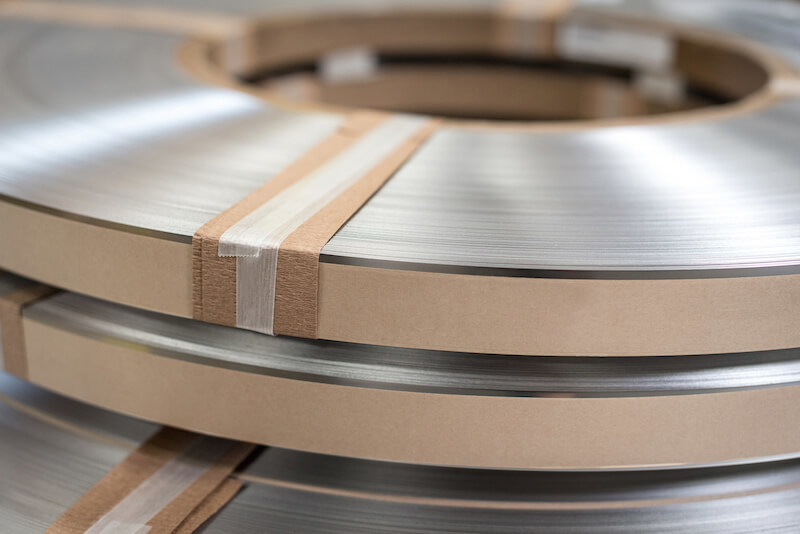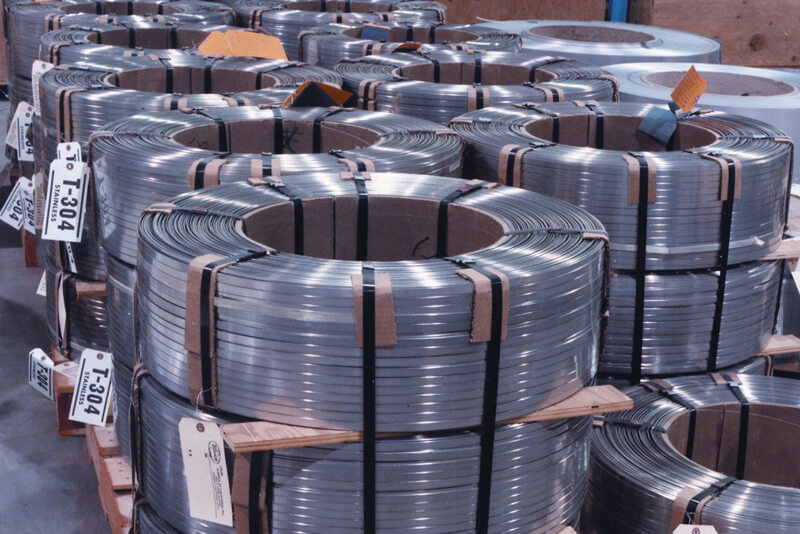Stainless steel is different from other types of steel in that it contains nickel, chromium and other alloying elements. This key difference provides it with a much improved degree of corrosion resistance.

Image Credit: Ulbrich Stainless Steels & Special Metals.
A huge amount of variation exists within the world of stainless steel, with well over 100 unique grades of stainless steel available currently. The majority of these grades fall within five general categories:
- Austenitic stainless steel
- Duplex grades
- Precipitation-hardening stainless alloys
- Ferritic stainless steel
- Martensitic stainless steel
Every one of these types of stainless steel has a unique series of metallurgical qualities. While different types have distinct strengths and weaknesses, each type is suitable for a wide range of potential applications.
This particular article takes a more detailed look at ferritic stainless steel, summarizing some basic information about how ferritic steel is graded, and what makes it different from other forms of stainless steel.
What is Ferritic Stainless Steel?
Ferritic steel is a grade of stainless steel alloy that contains over 12% chromium. It differs from other forms of stainless steel in two critical regards: its molecular grain structure and its chemical composition.
Ferritic stainless steel is actually defined as a straight chromium non-hardenable class of stainless alloys that have chromium contents ranging from 10.5% to 30% and a carbon content of less than 0.20%.
These steels are non-hardenable by heat treatment, and only marginally hardenable by cold rolling. Ferritic stainless grades include:

Image Credit: Ulbrich Stainless Steels & Special Metals.
What is the Chemical Composition of Ferritic Steel?
As discussed previously, all types of stainless steel incorporate chromium, which is striking for its corrosion resistance, hardness and extraordinary gloss when polished. Ferritic steels are unique in the sense that they typically contain higher amounts of chromium than other forms of stainless steel.
For example, one of the most commonly used types of austenitic steel —18/10 stainless — contains 18% chromium — however, it contains no nickel unlike austenitics.
In contrast, ferritic stainless steels can contain chromium levels that are as high as 27%. Not all types of ferritic stainless steel contain high amounts of chromium however; in some cases they have even less than their austenitic equivalents.
One universal difference between ferritic and austenitic stainless steels is that ferritic stainless steels contain little or no nickel. They share this trait with martensitic stainless steels, the majority of which also contain no nickel. Lastly, ferritic steels are typified by the fact that they contain hardly any carbon.
The Ferritic Grain Structure
A stainless steel’s composition plays a large part in how the metal is structured on a molecular level. Those structures are actually what give the various types of stainless steel their names. For example, ferritic steels are so called because they are made up of the microstructures known as ferrite.
Ferrite is a metallurgical phase of iron within which metallic alloying elements are in a solid solution, but carbon is effectively insoluble. Ferrite is practically absent in quenched martensitic and austenitic stainless steels, but its presence is what characterizes stainless steels. It is also worth noting that annealed martensitic stainless steels also contain carbide and ferrite.
Without getting too much deeper into the chemistry of metal formation, it should be noted that the various alloys of stainless steel mainly differ in terms of where the iron atom is located within each grain.
Ferritic steels have a body-centered-cubic grain structure. Austenitic and other types of stainless steel, however, possess a face-centered grain structure.
The body-centered-cubic grain is responsible for ferritic steel’s magnetic nature; this differs from all other types of stainless steel. This distinction lies in the quantum-mechanical aspect of the metal's microstructures — that is, the way the electrons are arranged at the core of the metal's grain.

Image Credit: Ulbrich Stainless Steels & Special Metals.
Characteristics of Ferritic Stainless Steel Strip
There are five important characteristics to be aware of when considering the performance of ferritic stainless steel.
Steel with Resistance to Stress Corrosion Cracking
Stress corrosion cracking (SCC) is a frequently occurring type of steel degradation which is triggered by a combination of a corrosive environment and tensile stress. Austenitic stainless steels are especially vulnerable to SCC when exposed to chlorides. However, the microstructures present in ferritic steels, afford them a high degree of resistance to SCC, making them a good choice for use in environments and applications where chlorides may be present.
Stainless Grades Which Have Good Ductility and Formability
Steel’s hardness comes from carbon, yet carbon also contributes to making steel less ductile and more brittle. Because ferritic steel contains carbon levels as low as 0.03% they usually possess above average ductility. This means that ferritic steels can be shaped considerably without risk of weakening.
Ferritic steels’ low carbon content also provides them with exceptional formability properties, allowing them to be formed into numerous shapes without having to contend with problems such as cracking or necking.
The benefits of ferritic steel's low-carbon composition do come with certain compromises though. For example, it is not possible to harden ferritic steels through heat treatment. Additionally, some types of ferritic steel may display problems when welded, such as unexpected cracking along the heat-affect zone.
Types of Stainless Exhibiting Low Thermal Expansion
Ferritic steels have a naturally low coefficient of thermal expansion. This can be a real benefit, and simply means that ferritic steels will undergo less expansion as they take on heat.
Because the metal will retain its fixed dimension more readily, this makes ferritic stainless steels well suited to high temperature applications.
Stainless Steels Known to Have High Thermal Conductivity
Ferritic stainless steels possess outstanding thermal conductivity attributes, meaning that heat can move through them efficiently. As a result, ferritic steels see widespread use in furnace and boiler heat exchangers, as well as other applications involving the transfer of heat.
Stainless Steel with High Oxidation Resistance
Lastly, ferritic stainless steel is exceptionally resistant to oxidation, notably at high temperatures. This resistance is a result of the formation of a protective chromium-oxide film on the steel’s surface. It is possible to improve oxidation resistance even more by including silicon and/or aluminum when manufacturing ferritic steel.
What is a Ferroalloy?
A ferroalloy is an iron-bearing product that does not fall within the range of those known as steels, but which still contains a considerable amount of one or more alloying elements.
These elements may include ferromanganese, silicon, vanadium, phosphorous, chromium, ferrophosphorous, manganese, etc. The primary role of these alloys is for making additions of their respective alloying elements to molten steel.

Image Credit: Ulbrich Stainless Steels & Special Metals.
The Five Groups of Ferritic Stainless Steel
Ferritic stainless steels can be further divided into five distinct groups. These groups vary in terms of the precise amounts of different metals they contain, as well as their particular performance attributes.
- Group 1 ferritic steels are among the least expensive types of stainless steel. They have extremely low chromium levels, meaning that they tend to gather a layer of localized surface rust over time.
- Group 2 ferritic steels are the most commonly used type. Because of their higher chromium levels, these steels possess greater corrosion resistance. Group 2 ferritic steels are generally used for building features and interior appliances.
- Group 3 ferritic steels are well known for their ease of forming and welding, meaning they are suitable for a wide range of applications.
- Group 4 ferritic stainless steels contain higher amounts of molybdenum, further improving their corrosion resistance. This type of steel is commonly used for high-moisture applications like exhaust systems and hot water tanks.
- Group 5 ferritic steels have the highest chromium levels, giving them a degree of corrosion resistance which is unmatched by all but a handful of other metals.
No single stainless steel is suitable for all tasks or environments. As such, it is important to select the grade of steel that is best suited for the application in question. The industry experts at Ulbrich Stainless Steels & Special Metals are available to help select the right grade of stainless steel strip or wire for any project.

This information has been sourced, reviewed and adapted from materials provided by Ulbrich Stainless Steels & Special Metals, Inc.
For more information on this source, please visit Ulbrich Stainless Steels & Special Metals, Inc.